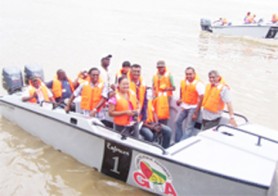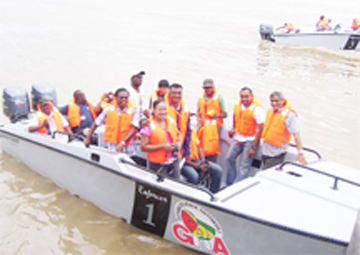The Guyana Revenue Authority’s (GRA) efforts to combat smuggling were boosted yesterday with the arrival of three state-of-the-art surveillance boats.

The acquisition reflects a more than US$180,000 investment by the GRA, which is to become more independent in its attempts to reduce the annual revenue loss to illegal trading, estimated at between five and ten per cent.
The vessels, Enforcer 1, 2 and 3 which bear the GRA logo in bright colours, arrived at the John Fernandes Wharf yesterday morning. They are outfitted with sirens, radio sets and horsepower engines that could hold up to 200 gallons of gasoline and travel at a speed of up to 100 miles per hour. One of the boats is equipped with double engines and could be on water for up to eight hours.
The vessels, manufactured in Miami, can each carry up to ten enforcement officers at any one time and are highly manoeuvreable and come equipped with facilities for weapons storage.
GRA boss Khurshid Sattaur, who was on hand to see the vessels taken for early tests in the Demerara River, told reporters that the boats were specially designed for enforcement and with their deployment he expects increased interception of illegal traders who have been evading the tax system. “We have decided to take the bull by the horns and so we have gotten our own facilities and we would be able to make more direct interception. So our primary focus is to intercept those unauthorized boats bringing illegal stuff, whether it be foodstuff or alcohol because this is very prevalent now,” he said.
Previously, the Guyana Defence Force Coastguard had been assisting the GRA in these efforts.
Sattaur said he anticipated maintenance issues with the boats but noted that they would have to be addressed. The benefits of the investment, he added, would be seen in the longer term, since it would help provide a level playing field for legitimate dealers who currently face unfair competition because of the illegal importation of goods.
However, while the GRA makes these efforts, Sattaur issued an appeal for public co-operation, since a lot of the interception would depend on the intelligence received.
In this regard he said a reward system would be implemented. “I consider this a significant investment of taxpayers’ dollars and it would help us to bring in much of the revenue escaping the system,” he said.
Meanwhile, he revealed that the body invested a further $85 million in building a warehouse at Eccles East Bank Demerara to provide storage for intercepted goods.
Many illegal items come from the Cayman and other islands, where there are free ports, as well as Venezuela and Suriname. Smuggling is further facilitated by the fact that Guyana has over 200 miles of waterways which are virtually unprotected.
Sattaur said there was a delay in the acquisition of the vessels but he noted that this gave the GRA enough time to prepare and plan and get the warehouse construction underway. However, he pointed out that the officers who will operate the boats will have to get specialized and intense training, which is expected to begin shortly.
He emphasised that the GRA would conduct its activities independently. When asked how the body expects to guard against corruption, Sattaur said that officers will be trained in upholding integrity. He, however, pointed out that the GRA could hope that the staff had the right “indoctrination” and would do their jobs professionally.

